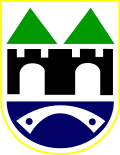Mula Mustafe Bašeskije Street
 | |
| Native name | Ulica Mula Mustafe Bašeskije (Bosnian) |
|---|---|
| Location | Sarajevo, Bosnia and Herzegovina |
| Postal code | 71000 |
| Coordinates | 43°51′32″N 18°25′41″E / 43.8590°N 18.4280°E |
| Other | |
| Known for | Historic landmarks, cultural institutions |
Mula Mustafe Bašeskije Street (Bosnian: Ulica Mula Mustafe Bašeskije; Serbo-Croatian Cyrillic: Улица Мула Мустафее Башескије) is a prominent street located in the heart of Sarajevo, the capital of Bosnia and Herzegovina. Situated in the historic districtz of Stari Grad and Centar, the street is renowned for its rich history, cultural landmarks, and as a hub of scholarly and religious institutions.[1]
Etymology
[edit]The street is named after Mula Mustafa Bašeskija, an 18th-century Bosnian chronicler, poet, and calligrapher.[2] Bašeskija is best known for his detailed chronicles that provide invaluable insights into the social, cultural, and political life of Sarajevo during the Ottoman period.[3]
History
[edit]Mula Mustafe Bašeskije Street has been a central artery in Sarajevo's urban fabric since the Ottoman era. Over the centuries, it has witnessed various transformations, reflecting the city's dynamic history. The street has been known by different names throughout its existence, corresponding to the prevailing political and cultural influences of the time.
Landmarks
[edit]The street is home to several significant landmarks:
- Eternal Flame: Located at the junction of Mula Mustafe Bašeskije, Titova, and Ferhadija streets, this memorial was dedicated on April 6, 1946, to honor the military and civilian victims of World War II in Sarajevo. Designed by architect Juraj Neidhardt, it remains a site of annual commemorations.[4]
- Bosniak Institute: Situated at Mula Mustafe Bašeskije 21, the Bosniak Institute is a cultural and scholarly institution founded by Adil Zulfikarpašić. It encompasses a museum, gallery, library, and archives, aiming to preserve and promote the cultural heritage of Bosniaks and other peoples of Bosnia and Herzegovina. The institute is adjacent to the historic Gazi Husrev-bey's Hammam.[5]
- Stambeno-poslovna zgrada u ulici Mula Mustafe Bašeskije: Located at number 5, this residential-commercial building, originally the administrative building of the Trgovačko-transportnog akcionarskog društva, is one of the earliest examples of Secessionist architecture in Sarajevo. Designed by architect Josip Vancaš in the early 20th century, it has been designated as a National Monument of Bosnia and Herzegovina.[6]
Cultural significance
[edit]Mula Mustafe Bašeskije Street serves as a microcosm of Sarajevo's diverse cultural and historical tapestry. Its array of religious, educational, and cultural institutions reflects the city's long-standing tradition of multicultural coexistence. The street continues to be a vibrant part of Sarajevo's urban life, attracting both locals and tourists interested in its rich heritage.[7]
See also
[edit]References
[edit]- ^ "Mula Mustafe Bašeskije". Destination Sarajevo. Visit Sarajevo. Retrieved 17 April 2025.
- ^ Esad Duraković, ed. (2005). "Mula Mustafa Bašeskija". Enciklopedija Bosne i Hercegovine (in Bosnian). Sarajevo: Svjetlost. pp. 134–135.
- ^ "Mula Mustafa Bašeskija – hroničar duše Sarajeva". Basics.ba. Basics Magazin. 15 January 2022. Retrieved 17 April 2025.
- ^ "Održana komemoracija kod Vječne vatre: Ne smijemo zaboraviti heroje koji su branili Sarajevo". Klix.ba. InterSoft d.o.o. 6 April 2023. Retrieved 17 April 2025.
- ^ "Bosniak Institute – Foundation Adil Zulfikarpašić". Bosniackiinstitut.ba. Retrieved 17 April 2025.
- ^ "Ulica Mula Mustafe Bašeskije". Sarajevo.travel. Visit Sarajevo. Retrieved 17 April 2025.
- ^ "Godišnjica smrti Mula Mustafe Bašeskije – ljetopisca čiji su zapisi najpouzdaniji podaci o Sarajevu iz 18. stoljeća". Grad Sarajevo. sarajevo.ba. 18 August 2021. Retrieved 17 April 2025.

